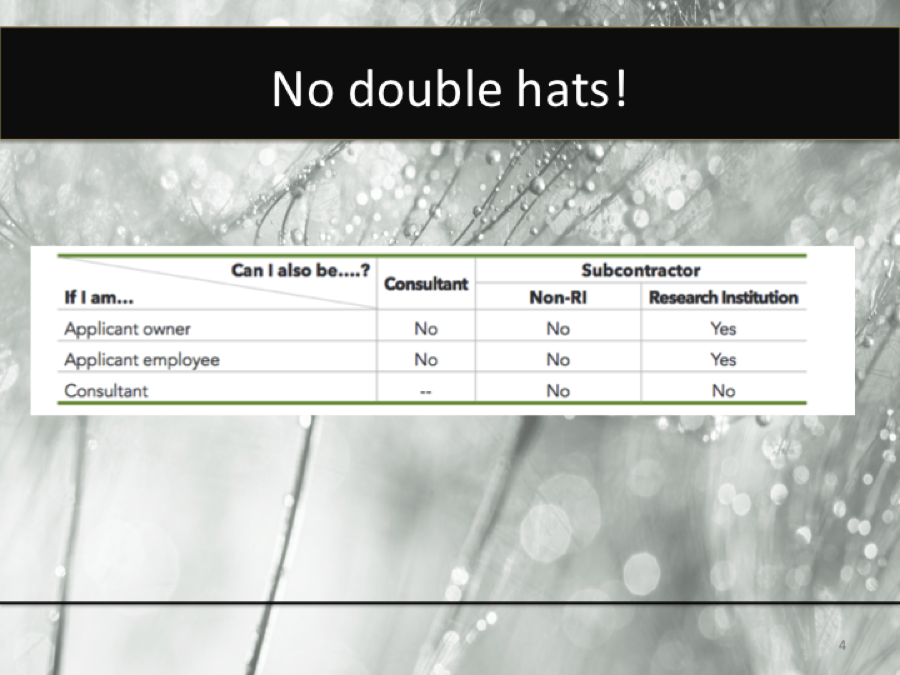Tutorial 26:
What is the Difference between Consultants and Subcontractors?
Subcontractors and consultants can be important contributors to a Phase I DOE SBIR/STTR project. They can bring expertise to the project not found among the employees of the applicant small business, and subcontractors also can provide sophisticated facilities and equipment that the applicant could not otherwise access or afford. But what is the difference between a consultant and a subcontractor?
Before defining the difference, let’s clarify what relationship either may have with the SBIR/STTR applicant small business. Both consultants and subcontractors will be under a subcontract, which is defined in the DOE FOA Appendix A as “any agreement, other than one involving an employer-employee relationship, entered into by the primary recipient of a Federal government grant, calling for supplies or services required solely for the performance of the original grant award.” In other words, if a third party, either an individual or entity, is contributing to another small business’s SBIR/STTR proposal, then the agreement to do so is referred to as a subcontract. That means that either a subcontractor or a consultant will have a subcontract with the applicant small business.
To differentiate a consultant from a subcontractor, let’s first look at DOE’s definitions of a consultant. DOE’s Funding Opportunities Announcement (FOA), Appendix A says “A consultant is generally an individual who is not using any institutional or organizational facilities and is acting as a direct agent. The individual usually bills by the hour, submitting invoices. Invoices occasionally include additional direct expenses incurred. Consultants are normally subject matter experts and are not directly supervised by the awardee.” And in its Instructions for Completing a DOE SBIR/STTR Phase I Grant Application, DOE defines a consultant as “An individual who provides professional advice or services for a fee, but normally not as an employee of the engaging party…Consultants may also include firms that provide paid professional advice or services.” This suggests several common characteristics of consultants: they usually are individuals, they typically are not part of a larger company, and they provide advice and services.
In contrast, subcontractors tend to be organizations, ranging from universities and Federal Laboratories to Fortune 100 companies to other small businesses. And their scope tends to be broader, “…providing technical expertise, facilities, or equipment.”
Therefore, in general, consultants are individuals and subcontractors are organizations or entities, and consultants tend to be limited to providers of services and advice, while subcontractors can provide a broader array of resources for an SBIR/STTR project.
However, this is not a hard and fast distinction. Note the use of “generally,” “normally,” “occasionally” and “usually” in the DOE definitions of a consultant, and the statement that “Consultants may also include firms…”
There appears to be some flexibility in whether the third party on an SBIR/STTR subcontract could be treated as a consultant or a subcontractor. Are there reasons to prefer one over the other, if there is a choice?
Yes, there are, for several reasons:
- If it’s an STTR project, then the applicant small business must team with a non-profit subcontractor. This subcontractor is known as the Research Institution (RI), and typically is a university or Federal Laboratory. A consultant could not serve as the RI on an STTR. Put another way, the university could be the RI on your STTR project, but one of its professors acting as an independent consultant in her free time could not.
- Bringing a university faculty member onto your project as a consultant may reduce the time, cost and administrative burden associated with making him or her part of your team.
- Bringing a university or Federal Laboratory staff member onto your team as a consultant also may avoid some of the intellectual property issues that can arise if the university or Lab is made a subcontractor on the project. However, this is not always the case—some such institutions require, through their employment agreements, that any IP created by their staff members belongs to the institution, even if the staffer created it in their “personal time.”
- Having a well known institution or company as a subcontractor can elevate the credibility and prestige of the small company applicant in ways that may not be possible if just an individual joins the team as a consultant.
- The exception to this is when that individual is well known and respected in his/her own right.
- Having a large subcontractor, such as a university or large corporation, may discourage potential IP infringers that do not want to create a legal issue with a large player that has substantial resources for litigation
In a Phase I SBIR project, the applicant small business can subcontract up to 33% of the research effort. Remembering that a subcontract can be with a consultant and/or a subcontractor, this means the applicant has considerable latitude about who it brings onto its Phase I proposal and project. On an STTR project, things are more restrictive: the applicant must subcontract at least 30% of the research to the RI, a non-profit subcontractor. The applicant itself must do at least 40% of the research—this leaves a difference of 100-30-40=30% of the research that the applicant can do itself, subcontract to the RI, or award to a consultant or additional subcontractor.
A DOE STTR project also provides greater flexibility regarding the place of employment of the principal investigator (PI). Whereas the PI must be primarily employed by the small business applicant in an SBIR, it is possible for him/her to be primarily employed by the RI on a DOE STTR project. However, a key word here is “employed;” in neither an SBIR nor an STTR can the PI be a consultant, subcontractor, or anything other than an employee.
We’ll close with some final observations:
First, the role of subcontractors and consultants in a Phase I DOE SBIR/STTR project must be clearly defined and described in the work plan in the Project Narrative portion of the grants.gov application. DOE also expects each subawardee to be clearly identified and defined in the proposal as a subcontractor or consultant.
Second, DOE does not allow an individual on an SBIR/STTR project to “wear multiple hats.” The following table and charts summarize the limitations.
As the following table shows, if you are an owner or employee of the applicant small business, then you cannot also be a consultant, or employee of a subcontractor on the project. The exception is if the subcontractor is an RI like a university or Federal lab; for example, if a professor is part owner of the applicant business, he/she also can be on the faculty of the university subcontractor on the DOE project. But if you are a consultant on a Phase I DOE SBIR/STTR project, you cannot also be an employee of a subcontractor on the same project.
Third, consultants should be listed on the Research & Related: Senior/Key Person Profile form, and their bio sketches and current/pending support lists should be attached to that form.
Finally, the combined budgets for all consultants should be included under Section F.3 of the Research & Related: Budget Form. The combined budget for all of your subcontractors should be included in Section F.5. Also, subcontractors will need to complete subaward budget forms that become attachments to your Related & Research: Subaward budget attachment(s) form in your grants.gov DOE Phase I application. This is not required for consultants that are single individuals, because only those in the consortium must do so, and DOE defines consortium as “A formalized agreement whereby a research project is carried out by the grantee and one or more other organizations that are separate legal entities. (emphasis added).”
Quiz: Tutorial 26: What is the Difference between Consultants and Subcontractors?
1
Which of the following statements is NOT accurate?
Nice Work
Try Again
2
A Research Institution is one kind of subcontractor, and is a required part of an STTR application.
Nice Work
Try Again
3
If you treat a university or Federal Lab employee as a consultant on your SBIR/STTR project, you don’t have to worry about the intellectual property requirements of their institution.
Nice Work
Try Again
4
Which of the following statements are accurate?
Nice Work
Try Again



